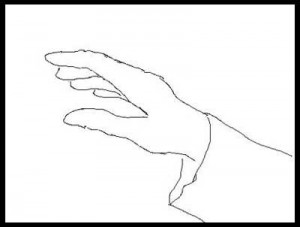How to find inexpensive and free mosaic patterns

- The images have just enough detail, but not too much. The drawing needs to be simple because it’s only a map. The details, shading and texture come when you add the tile. Most importantly, it doesn’t make sense to sketch out details that are smaller than your smallest mosaic tile. Refer to the sketch on the right. If you were to make a mosaic of a hand, you probably wouldn’t need or want a sketch any more detailed than that.
- Coloring books come in most every theme imaginable: human figures, historical events, animals, vehicles, ships, mythological creatures, famous architecture, etc. Why buy a generic pattern from a stained glass store when you can find more specific images in a coloring book?
- Coloring books are cheap and available most anywhere.
- You can change the pictures or combine several into one scene.
Customizing a Mosaic Pattern
Visual noise is good! Since you will probably be converting a simple image wtih little detail into a more complex work of art, it’s necessary to add your own elements of depth, dimension and style as you choose tiles for color, texture and shading. It’s all in the details. As you work, remember to “color outside the lines” and don’t worry about fixing every “mistake.” A little “visual noise” can make a work of art much more interesting.- Consider using 2 different colors or shades of the same color instead of only 1 color to create highlights and shading, giving flat shapes some depth.
- Use bold outlining. Outlines should be clear and dark but not thick. Big thick outlines make images hard to see.
- Incorporate multiple design elements into one work, such as ornamental bordering, or use multiple designs together to create a central theme.
- Experiment with tiles or stones with varying texture and unexpected color.
- Improvise by modifying the pattern to make it work for you.
¹ Make sure you write and ask for permission if you are using copyright material, especially if the mosaic is for a commission or public space. The suggestions on this page are intended primarily for mosaics for personal use.
Transferring and Enlarging Patterns
Need a larger pattern for your mosaic but can’t draw? No problem. There is a simple technique that is used all the time, even by people who haven’t learned to draw freehand. The solution is to trace a light grid over the original drawing using a pencil and ruler and then quickly and easily copy the contents of the grid onto a similar yet larger grid. Ex: Let’s say we have a small drawing that is 10″ x10″ and we want to use that drawing as the pattern for a table that is 24″x 24″:- Take a ruler and pencil and trace a grid on your original pattern. For example, draw a line every 1 inch both horizontally and vertically so that the pattern is covered by a grid of 1 inch squares. In this example, that would mean 10 columns by 10 rows.
- Take the ruler and pencil and trace a grid with the same number of lines on the table. But the table is larger. How far apart should you make the lines? We divide the width of the table by the number of rows: 24 inches divided by 10 rows = 2.4 inches per row. That means we trace a line every 2.4 inches on the table.
- Now we have a pattern covered in 100 squares and a table covered in 100 larger squares. Look at the grid on the pattern and notice that the pattern doesn’t look that complicated when divided up into 100 pieces. In fact, each of the 100 squares probably only contain one simple line.
- Simply copy one square at a time. Notice that it is easy and fast to copy each of the squares without “drawing” in a mental sense because you are only making a line or maybe two in each of the squares.
[…] Mosaic Patterns […]